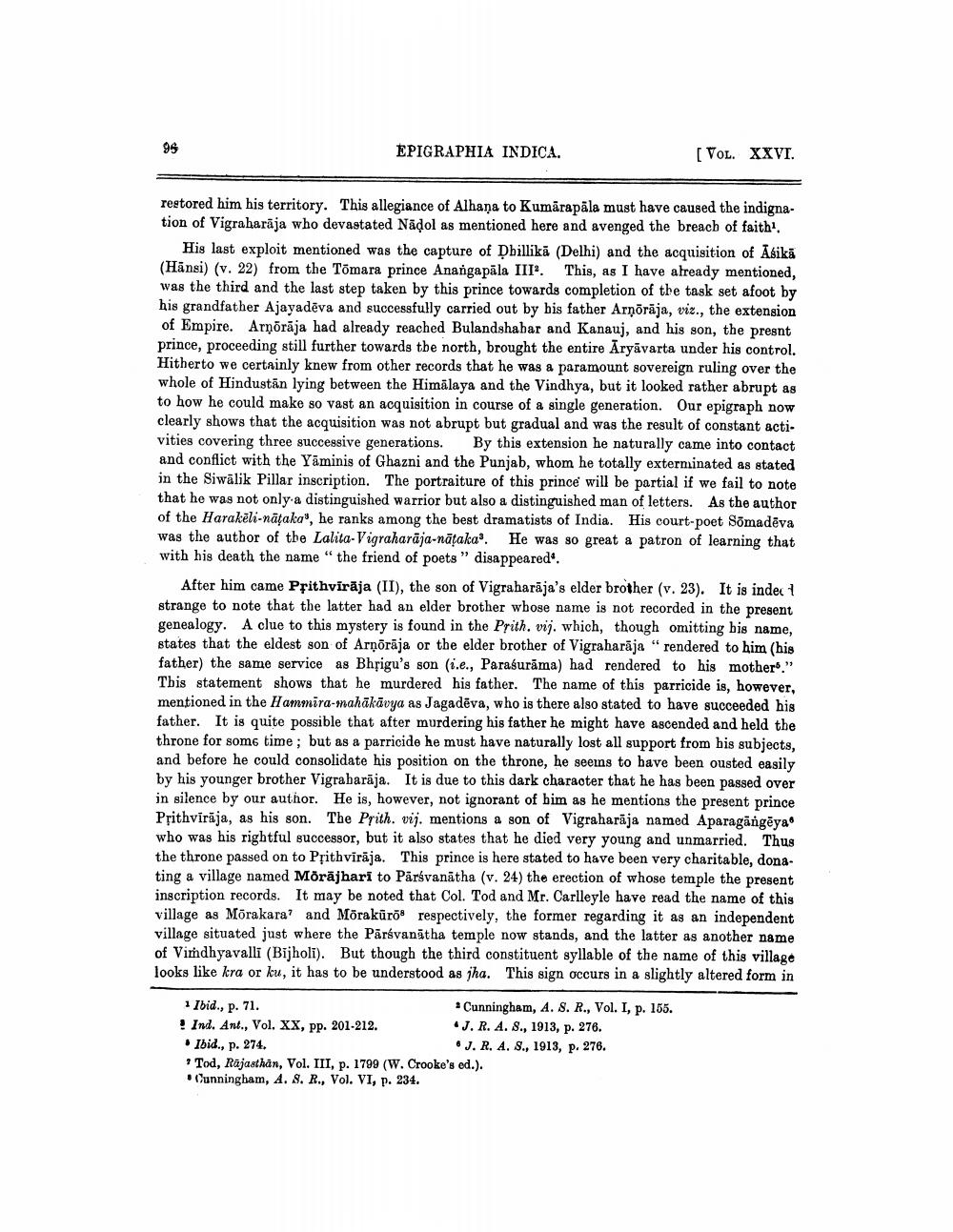________________
Is
EPIGRAPHIA INDICA.
[Vol. XXVI.
restored him his territory. This allegiance of Alhaņa to Kumārapāla must have caused the indignation of Vigraharaja who devastated Nädol as mentioned here and avenged the breach of faith.
His last exploit mentioned was the capture of Dbillikā (Delhi) and the acquisition of Asikā (Hänsi) (v. 22) from the Tomara prince Anangapāla III. This, as I have already mentioned, was the third and the last step taken by this prince towards completion of the task set afoot by his grandfather Ajayadēva and successfully carried out by bis father Arnorāja, viz., the extension of Empire. Arnorāja had already reached Bulandshahar and Kanauj, and his son, the presnt prince, proceeding still further towards the north, brought the entire Aryāvarta under his control. Hitherto we certainly knew from other records that he was a paramount sovereign ruling over the whole of Hindustan lying between the Himalaya and the Vindhya, but it looked rather abrupt as to how he could make so vast an acquisition in course of a single generation. Our epigraph now clearly shows that the acquisition was not abrupt but gradual and was the result of constant acti. vities covering three successive generations. By this extension he naturally came into contact and conflict with the Yāminis of Ghazni and the Punjab, whom he totally exterminated as stated in the Siwālik Pillar inscription. The portraiture of this prince' will be partial if we fail to note that he was not only a distinguished warrior but also a distinguished man of letters. As the author of the Harakēli-nāšaka, he ranks among the best dramatists of India. His court-poet Somadēva was the author of the Lalita-Vigraharāja-nātaka'. He was so great a patron of learning that with his death the name “the friend of poets” disappeared.
After him came Prithvirāja (II), the son of Vigraharāja's elder brother (v. 23). It is indec strange to note that the latter had an elder brother whose name is not recorded in the present genealogy. A clue to this mystery is found in the Prith. vij. which, though omitting bis name, states that the eldest son of Arnorāja or the elder brother of Vigraharāja "rendered to him (his father) the same service as Bhrigu's son (i.e., Parasurăma) had rendered to his mother." This statement shows that he murdered his father. The name of this parricide is, however, mentioned in the Hammira-mahākāvya as Jagadēva, who is there also stated to have succeeded his father. It is quite possible that after murdering his father he might have ascended and held the throne for some time, but as a parricide he must have naturally lost all support from his subjects, and before he could consolidate his position on the throne, he seems to bave been ousted easily by his younger brother Vigrabarāja. It is due to this dark character that he has been passed over in silence by our author. He is, however, not ignorant of bim as he mentions the present prince Prithviraja, as his son. The Prith. vij. mentions a son of Vigraharāja named Aparagāngeya who was his rightful successor, but it also states that he died very young and unmarried. Thus the throne passed on to Pțithvirāja. This prince is here stated to have been very charitable, donating a village named Mörājhari to Pārsvanātha (v. 24) the erection of whose temple the present inscription records. It may be noted that Col. Tod and Mr. Carlleyle have read the name of this village as Morakara? and Morakūro respectively, the former regarding it as an independent village situated just where the Pārsvanátha temple now stands, and the latter as another name of Vindhyavalli (Bijholi). But though the third constituent syllable of the name of this village looks like kera or ku, it has to be understood as jha. This sign occurs in a slightly altered form in
1 Ibid., p. 71.
. Cunningham, A. S. R., Vol. I, p. 155. ! Ind. Ant., Vol. XX, pp. 201-212.
*J. R. A. 8., 1913, p. 276. . Ibid., p. 274.
. J. R. A. 8., 1913, p. 276. + Tod, Rājasthan, Vol. III, p. 1799 (W. Crooke's ed.).
Cunningham, A. S. R., Vol. VI, p. 234.




